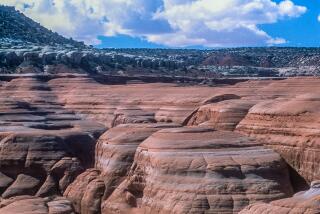Solid as a Rock
- Share via
LITTLE COTTONWOOD CANYON, Utah — Deep beneath the sheer rock face, 60-million-year-old fossil fish hang among World War I posters plugging war bonds.
There are Chinese gambling tokens--tiny glass disks with intricate, hand-painted designs from the Ming Dynasty--and bronze sculptures by cowboy artist Frederic Remington.
They are all works worthy of public display, but they are buried in a vault beneath more than 200 feet of solid granite for safekeeping.
“We don’t let a lot of people up here,” said Jim Nowa, spokesman for Perpetual Storage Inc. “If you had a red ‘S’ on your chest you could probably get through, but you’d set off an alarm.”
The Perpetual Storage vault is one of two in Salt Lake City’s Little Cottonwood Canyon. The Church of Jesus Christ of Latter-day Saints also has a vault there, where it stores priceless genealogical and other church records.
Both sit in a place considered to be perhaps the most geologically secure along the Wasatch Front. They are bored into a single granite rock that starts at the mouth of the canyon and extends 3 1/2 miles east.
If Nowa was working during a major earthquake, he might not even notice.
The Mormon church vault opened in 1964. Perpetual Storage opened its door--there’s only one--four years later.
Business was slow the first few years. Before the days of computer database backup tapes, compact disks, fiberoptic disks and microfiche, people only stored art, artifacts and gold and silver bullion.
Most of the 157,500-square-foot vault stood empty.
“This company really struggled through the ‘70s. We could have built a roller rink or disco or high-tech bowling alley in there,” Nowa said. “This concept was ahead of itself. The thought of storing information was not in everyone’s minds.”
Now, rows and rows of metal cabinets and racks hold thousands of computer tapes and rolls of microfilm. Medical records, research projects and daily and weekly database backup tapes for just about every major corporation and public agency in the Intermountain West are in the collection.
Microfilm files contain a complete library of just about every newspaper published in Utah, Idaho, Wyoming and Arizona, providing a virtually irreplaceable chronology of the history of the West.
The company doesn’t store gold and silver anymore, and they’re picky about the types of personal collections they allow, Nowa said.
In recent years, he has turned away a Utah Jazz basketball player who wanted to store an antique car, a research group that wanted to store cryogenic cells and even an Ogden group that wanted to store mummies.
The group told Nowa they had learned how to mummify bodies Egyptian style. They wanted to store some in the climate-controlled vault because they believed DNA cloning would one day be possible.
Nowa said it wouldn’t have been worth trying to explain to future clients why mummies were hanging along the walls.
The vault’s two upper floors are metal grates that allow air circulation. The mountain itself keeps the temperature at a constant 60 degrees, and the air is mechanically recirculated every six hours to keep the humidity at 28%.
Changes in temperature or humidity can damage computer tapes stored in the vault by causing them to expand or contract. The vault doesn’t store paper records because they create a fire hazard and emit chemicals and gases as they age, Nowa said.
The unmarked road leading to the place is narrow, steep and intimidating.
“In the winter, that road is our best security device,” Nowa said.
The building at the entrance of the vault isn’t visible from the canyon road. Cameras aimed at the road and the parking lot show the guards inside who is coming. They can hone in on a license plate and check the tag registration to find the owner’s name. Everyone who enters is tested with a metal detector, and guards are armed with high-powered military rifles.
The LDS vault has six tunnels to Perpetual’s one. Company officials are thinking of adding a second tunnel, but it’s an expensive process. When built in 1967, the vault cost $750,000, Nowa said. The same complex today would cost around $6 million.
Storing information in such a place may sound extravagant to some folks, but Nowa said in the information age, the computer tapes stored in the vault are even more valuable than the fossils and artwork.
“The information is worth infinitely more,” he said.
In seconds, natural disaster could obliterate 20 years of cancer research, and virtually nothing prevents an angry employee from erasing a database.
But 200 feet of solid stone stand between the mountains of information stored in the vault and outside threats.
More to Read
Inside the business of entertainment
The Wide Shot brings you news, analysis and insights on everything from streaming wars to production — and what it all means for the future.
You may occasionally receive promotional content from the Los Angeles Times.










